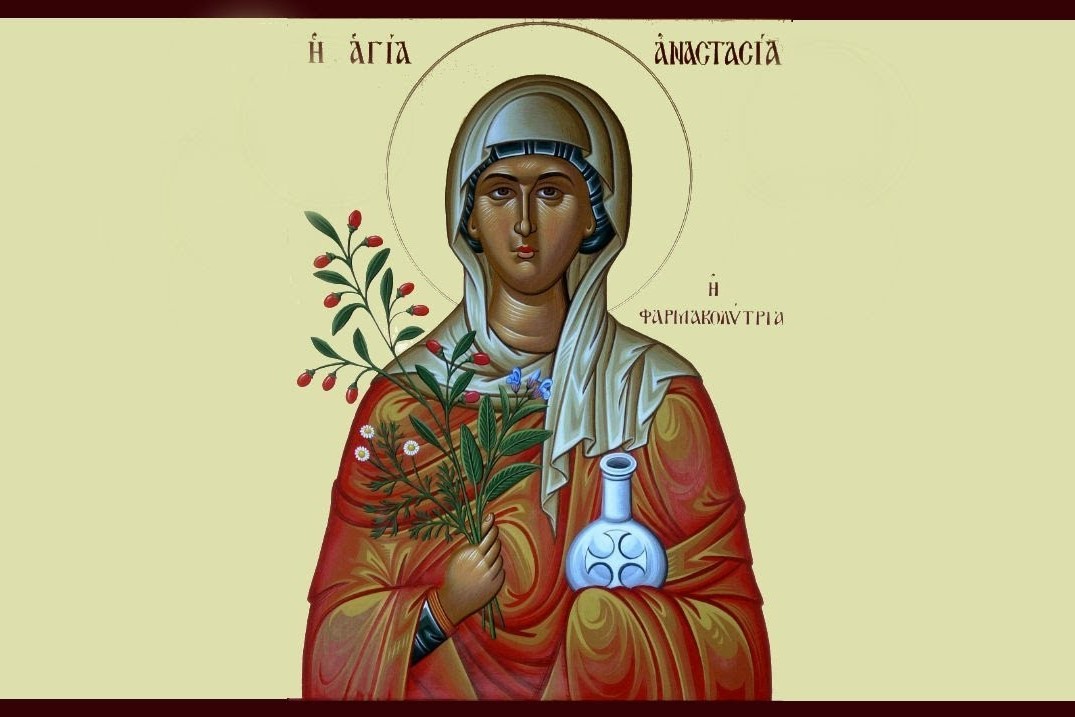
Saint Of The Day For December 25: Saint Anastasia Martyr of Sirmium
Anastasia, who lived in the time of Diocletian, helps the Christians of Rome who are persecuted by the emperor.
Arrested at Sirmio, in Illyria, refusing to renounce her faith, she is embarked on a pierced ship, but is saved.
Captured again, still refusing to abandon her faith, she is burnt alive.
The Life of St Anastasia
Anastasia was born in Rome into a patrician family, probably the gens Anicia.
Her father was a senator, her mother a Christian.
According to a late legend, Anastasia had Chrysogonus of Aquileia as her tutor.
She married, but her husband Publius opposed her charitable activities and segregated her at home.
After Publius’ death, she came to Sirmio (today Sremska Mitrovica) in Illyria, where she devoted herself to assisting persecuted Christians, particularly caring for those in prison.
Having discovered her faith, she was tried and, having refused to recant Christianity, was burnt alive, according to tradition, on 25 December 304, during the last persecution of Christians by the Emperor Diocletian.
The Cult of Anastasia
When, under Emperor Theodosius I, Christianity became the state religion, a church was dedicated to her in Sirmio.
Her devotion spread mainly in the eastern Roman provinces and her remains were brought to Constantinople and deposited in the Basilica of the Resurrection (Anastasis).
In Italy, the cult of Anastasia developed at the end of the 5th century, spread by the Goths and Lombards, and in the following centuries throughout Europe by the Benedictines, which explains the tradition according to which some of the saint’s relics were brought to the Benedictine abbey, of Longobard foundation, of Santa Maria in Silvis in Sesto al Reghena (PN).
A church in Verona and a basilica in Rome, to which a cardinal’s title is attached, were dedicated to the saint.
She was referred to, in Greek, as Pharmacolìtria (‘Healer from poisons’), and in Russian, as Uzoreshìtel’nitza (‘She who frees from bonds’), thus, both as a protector from disease and from the tricks of the devil.
She was also raised to the rank of ‘Great Martyr’ and included in the second list of martyrs named in the Roman Canon and the Ambrosian Canon during the celebration of the Eucharist.
Anastasia: A Saint in Space
After the Eastern Schism, the figure of Anastasia lost importance as a symbol of the link between the Catholic and Orthodox worlds.
Since, however, she is still among the saints venerated by both Churches, in 1995 two icons depicting her (one painted according to the Western tradition and the other according to the Eastern tradition) were sent into space on the MIR station as part of the mission “Saint Anastasia – a hope for peace” to contribute to the reconciliation of the peoples of the former Yugoslavia (the Croats and Slovenes are predominantly Catholic, the Serbs predominantly Orthodox).
The initiative was sponsored by UNESCO and the icons were blessed by Pope John Paul II, Patriarch Alexis II of Moscow and Patriarch Pavle of Serbia.
On their return to Earth, the icons arrived in Serbia, in Sremska Mitrovica, the land of the saint’s martyrdom, to contribute, according to the intentions of the Catholic and Orthodox Churches, to the peaceful coexistence of the Balkan peoples.
Subsequently, the icons were exhibited in a travelling exhibition, organised by the Russian painter Pierre Tchakhotine, which involved almost two hundred artists from all over Europe.
The first exhibition took place in 2005 in Sremska Mitrovica, then in 2006 in Jaroslav, Russia, then in Zadar, Croatia, and finally in Mondovì, Italy.
On the latter occasion, the installation project was entrusted to ArtStudioLetizia, which created a scenographic itinerary and a video installation dedicated to the life of the saint from Sirmio in the Palazzo di Città.
Read Also:
Saint Of The Day For December 19: Saint Anastasius
Saint Of The Day For December 17: Saint Daniel
Saint Of The Day For December 16: Saint David
Women And The Art Of Speech: Economy Of Francesco’s Solidarity With The Women Of Iran
8 December 1856: Lyon, SMA (African Missions Society) Is Founded
D.R. Congo: Congolese Catholics Take To The Streets To Protest Increasing Violence
DR Congo, They Were Organising A Peace March: Two Women Kidnapped In South Kivu
